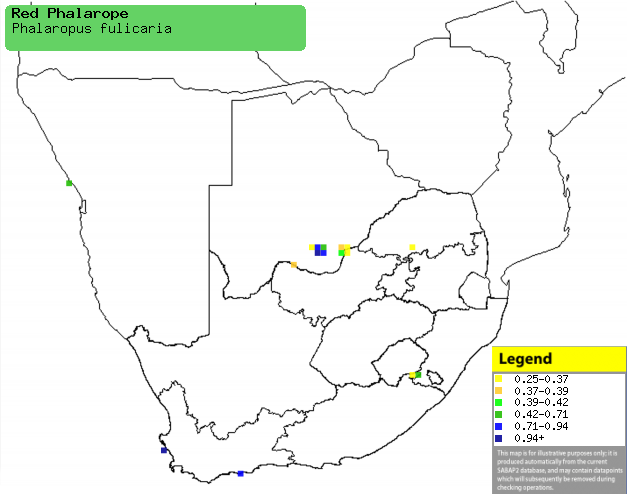|
Phalaropus fulicaria (Red
phalarope, Grey phalarope)
Grysfraiingpoot [Afrikaans]; Rosse franjepoot [Dutch];
Phalarope à bec large [French]; Thorshühnchen [German];
Falaropo-de-bico-grosso [Portuguese]
Life
> Eukaryotes >
Opisthokonta
> Metazoa (animals) >
Bilateria >
Deuterostomia > Chordata >
Craniata > Vertebrata (vertebrates) > Gnathostomata (jawed
vertebrates) > Teleostomi (teleost fish) > Osteichthyes (bony fish) > Class:
Sarcopterygii (lobe-finned
fish) > Stegocephalia (terrestrial
vertebrates) > Tetrapoda
(four-legged vertebrates) > Reptiliomorpha > Amniota >
Reptilia (reptiles) >
Romeriida > Diapsida > Archosauromorpha > Archosauria >
Dinosauria
(dinosaurs) > Saurischia > Theropoda (bipedal predatory dinosaurs) >
Coelurosauria > Maniraptora > Aves
(birds) >
Order: Charadriiformes > Family: Scolopacidae
Distribution and habitat
Breeds in the circumpolar region mostly above 65° North,
heading south in the non-breeding season to the sea, especially in the Humboldt,
Benguela and Guinea-Canary upwelling systems. It is a fairly common visitor to
southern African waters, occurring off the west coast (especially near southern
Namibia) and east up to the area off central Eastern Cape, while it is a vagrant
inland. It generally prefers the open ocean, especially where oceanic fronts and
upwelling plumes bring food to the surface, rarely moving to coastal salt works
or standing water bodies further inland.
|
 |
|
Distribution of Red phalarope in southern Africa,
based on statistical smoothing of the records from first SA Bird Atlas
Project (©
Animal Demography unit, University of
Cape Town; smoothing by Birgit Erni and Francesca Little). Colours range
from dark blue (most common) through to yellow (least common).
See here for the latest distribution
from the SABAP2. |
Movements and migrations
It first arrives in southern Africa in October,
with numbers peaking in December before it departs in March, rarely
April.
Food
It mainly eats zooplankton, supplemented with a variety of
other invertebrates taken opportunistically. It does most of its foraging by
pecking and lunging on the surface of the sea or plucking prey from rafts of
drifting seaweed. The following food items have been recorded
in its diet:
- zooplankton
- copepods
- insects and their larvae
- euphasid shrimps
- crabs
- barnacles
- freshwater gastropods
- parasites on whale skin
Threats
Not threatened.
References
-
Hockey PAR, Dean WRJ and Ryan PG 2005. Roberts
- Birds of southern Africa, VIIth ed. The Trustees of the John Voelcker
Bird Book Fund, Cape Town.
|
